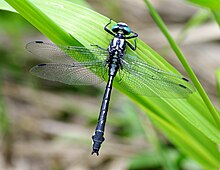Common wedge maid
| Common wedge maid | ||||||||||||
|---|---|---|---|---|---|---|---|---|---|---|---|---|

Common wedge damsel ( Gomphus vulgatissimus ), female |
||||||||||||
| Systematics | ||||||||||||
|
||||||||||||
| Scientific name | ||||||||||||
| Gomphus vulgatissimus | ||||||||||||
| ( Linnaeus , 1758) |
The common wedge damsel ( Gomphus vulgatissimus ) is a type of dragonfly from the family of the river damsel ( Gomphidae ), which belongs to the large dragonflies ( Anisoptera ). It was named Dragonfly of the Year 2017 by the Society of German-speaking Odonatologists and the BUND in Germany .
features
The common wedge damsel is a squat, strongly built dragonfly with a wingspan of 6 to 7 cm and a body length of about 5 cm. The wedge that gives the genus its name is a thickening of the last segments of the abdomen and is only pronounced in the males. Their typical, yellow-black drawing provides a good camouflage color both in the vegetation and on the ground and actually makes the species unmistakable, but at first glance it can be confused with other, similarly drawn river maids . Only in this species are the legs completely black.
distribution
The distribution area extends from the northern Iberian Peninsula to the Urals . The distribution limit runs in the north through England and southern Scandinavia, in the south from France via central Italy and northern Greece to the Caucasus . The altitude distribution is mostly limited to lower altitudes below 600 m, occasionally reproductive waters up to around 750 m can be found. However, individual stray individuals have already been detected in Switzerland up to 1400 m.
habitat
The common wedge damselfly inhabits flowing waters of the lowlands and the plains, from broad brooks over rivers and canals to large rivers. In addition, the bank areas of lakes and drainage waters such as dredging ponds are also used as habitats . The most important factor for the colonization of all habitats is relatively fine, mostly sandy or silty substrate as a habitat for the larvae, even on a very small scale. The frequently mentioned factor of moving water is likely to be significantly less important for the development of the species, since in still waters by no means only the surf banks of larger lakes are populated. In the case of waste waters, only the groundwater connection seems to have a certain importance.
Way of life
Flight time
The common wedge damsel is one of the first dragonflies in spring, its emergence period begins around the end of April and lasts into July. However, the majority of the animals hatch in the first four weeks. The flight time ends at the beginning of August, individual observations of adults are possible in exceptional cases until the beginning of September.
behavior
After hatching, the young adults leave the water and distribute themselves during a maximum two-week maturation period in the surrounding area, often several kilometers away from the developing water. They can only be found again in the water as sexually mature, adult animals. Usually, however, you can only observe the males there, who like to occupy areas of 10 to 20 m bank length on flowing waters , which are monitored from trees or stones on the lookout for females. The females only come to the water to mate and lay their eggs and are therefore rarely seen.
Mating and laying eggs
Mating is tedious and can take up to an hour, which the mating wheel spends motionlessly hidden in the vegetation near the water. Then the females fly alone to the water, where they sit down and squeeze a pea-sized egg lump with their abdomen lifted, which they then gradually wipe off on the surface of the water with rocking movements.
Larval life
The nocturnal larvae live buried in fine sediment such as sand or mud, where they quietly ambush their prey as high-seat hunters. The development cycle of the larvae comprises more than ten stages and is two, three or four years. The duration of the development cycle is probably not dependent on the geographical location or the climate, but on the type of water. A two-year development is only possible in large rivers with warm shallow water areas. In the meantime, there is even evidence of a year-long development of the larvae in newly created small bodies of water, which is certainly a rare exception.
literature
- Beutler H. (1991): The Flußjungfer. The children's book publisher, Berlin. ISBN 3-358-01694-3
- Müller O. (1995): Ecological studies on gomphids (Odonata: Anisoptera) with special consideration of their larval stages. Cuvillier, Göttingen. ISBN 3-89588-179-1
- Suhling F., Müller O. (1996): The river maids of Europe - Gomphidae. The new Brehm library 628. Westarp, Magdeburg and spectrum, Heidelberg. ISBN 3-89432-459-7
- Muller O. et al. (2000): Development time of Gomphus vulgatissimus: influence of water type and climate (Odonata: Gomphidae). Libellula 19: 175-198
- Sternberg, K., B. Höppner, A. Heitz, S. Heitz, & B. Schmidt (2000): Gomphus vulgatissimus (Linnaeus, 1558). Pp. 310-326. in: Sternberg / Buchwald (ed.): Die Libellen Baden-Württemberg. Volume 2: Dragonflies (Anisoptera). Ulmer, Stuttgart, ISBN 3-8001-3514-0
Individual evidence
- ↑ "Common Keiljungfer" is Dragonfly of the Year 2017. bund.net, accessed on December 22, 2017 .


